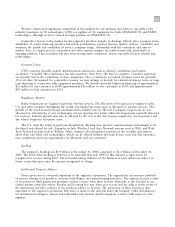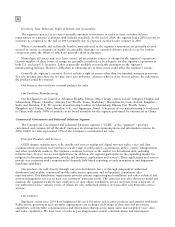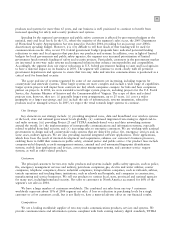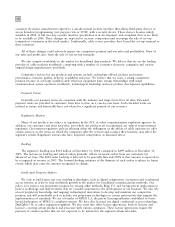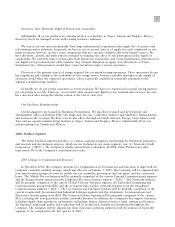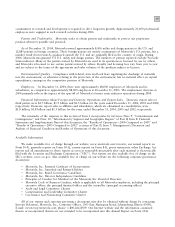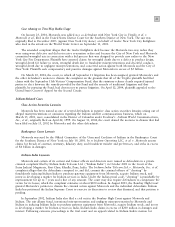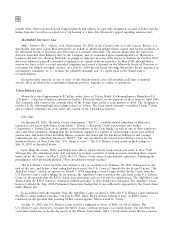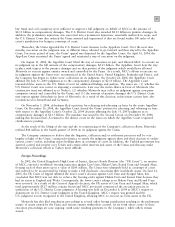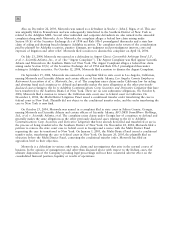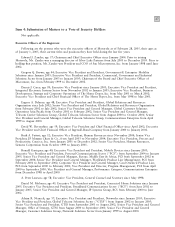Motorola 2004 Annual Report Download - page 25
Download and view the complete annual report
Please find page 25 of the 2004 Motorola annual report below. You can navigate through the pages in the report by either clicking on the pages listed below, or by using the keyword search tool below to find specific information within the annual report.
17
Inventory, Raw Materials, Right of Return and Seasonality
Substantially all of our products are manufactured at our facilities in Taipei, Taiwan and Nogales, Mexico.
Inventory levels are managed in line with existing business conditions.
We source our raw materials primarily from large multinational corporations that supply the electronics and
telecommunications industries. In general, we have access to several sources of supply for each component in our
major products; however, we have some components that are currently available only from limited sources. We
have inventory controls and other policies intended to minimize the eÅect of any interruption in the supply of
components. We currently source certain parts from Broadcom Corporation and Texas Instruments Corporation for
our digital set-top terminals and cable modems. Any material disruption in supply from Broadcom or Texas
Instruments for certain products would have a material adverse impact on our operations.
Electricity is the primary source of energy required for our manufacturing operations. These operations do not
have signiÑcant risk relating to the availability of this energy source; however, possible shortages in the supply of
electricity would aÅect the segment's operations. Labor is generally available in reasonable proximity to the
segment's manufacturing facilities.
Generally, we do not permit customers to return products. We have not experienced seasonal buying patterns
for our products recently. However, as our retail cable modem and digital set-top terminal sales increase, we may
have increased sales during the holiday season at the end of each year.
Our Facilities/Manufacturing
Our headquarters are located in Horsham, Pennsylvania. We also have research and development and
administrative oÇces in Rohnert Park, San Diego and San Jose, California; Andover and Marlboro, Massachusetts;
and Lawrenceville, Georgia. We have several sales oÇces throughout North America, Europe, Latin America and
Asia, and we operate manufacturing facilities in Taipei, Taiwan and Nogales, Mexico. Substantially all of our
manufacturing is in Taiwan and Mexico.
Other Products Segment
The Other Products segment includes: (i) various corporate programs representing developmental businesses
and research and development projects, which are not included in any major segment, and (ii) Motorola Credit
Corporation (""MCC''), the Company's wholly-owned Ñnance subsidiary. In 2004, Other Products net sales
represented 1% of the Company's consolidated net sales.
2005 Change in Organizational Structure
In December 2004, the Company announced a reorganization of its businesses and functions to align with the
Company's seamless mobility strategy, which was eÅective on January 1, 2005. The Company will be organized into
four main business groups, focused on mobile devices, networks, government and enterprise, and the connected
home. The Mobile Devices business will be primarily comprised of the current Personal Communications segment
and the Energy Systems group from the Integrated Electronic Systems segment (""IESS''). The Networks business
will be primarily comprised of the current Global Telecom Solutions segment, the Embedded Computing and
Communications group from IESS, and the next-generation wireline networks business from the Broadband
Communications segment (""BCS''). The Government and Enterprise business will be primarily comprised of the
current Commercial, Government and Industrial Solutions segment and the Automotive Communications and
Electronics Systems group from IESS. The Connected Home business will be primarily comprised of the current
BCS, excluding the next generation wireline networks business. In addition, the Company's key support functions,
including supply-chain operations, information technology, Ñnance, human resources, legal, strategy and business
development, marketing, quality and technology will be architected centrally and distributed throughout the
Company. The Company will be aligned into these four main operating segments with the analysis of reportable
segments to be completed in the Ñrst quarter of 2005.


